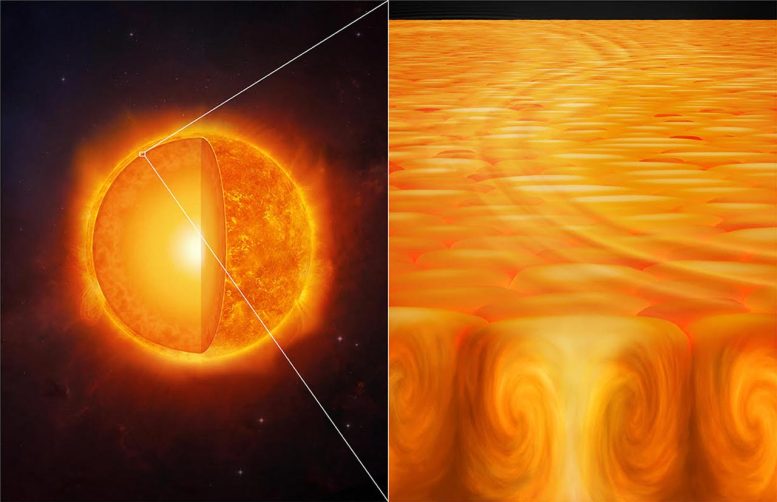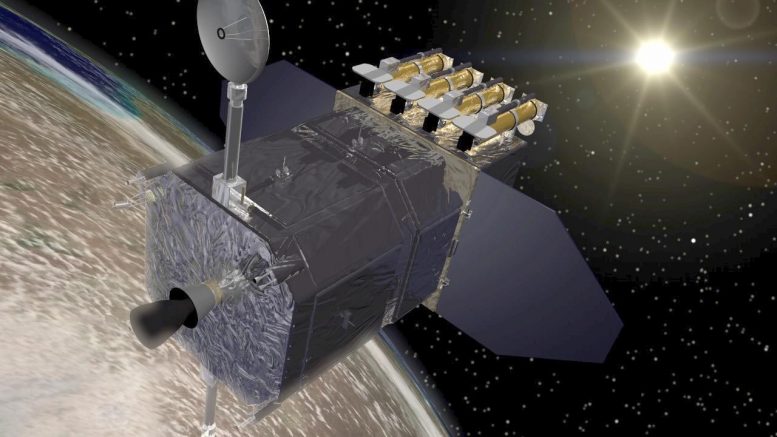.What Lies Beneath the Sun’s Surface? Solar Physicists Uncover Hidden Depths of Supergranules
http://blog.naver.com/mssoms
http://jl0620.blogspot.com
https://www.facebook.com/junggoo.lee.9
https://www.youtube.com/@SciTechDaily
.What Lies Beneath the Sun’s Surface? Solar Physicists Uncover Hidden Depths of Supergranules
태양 표면 아래에는 무엇이 있을까? 태양 물리학자들이 슈퍼과립의 숨겨진 심층을 발견하다

주제:천체물리학뉴욕대학교태양 역학 관측소별해 뉴욕 대학교 2024년 6월 25일 썬 슈퍼그레뉼 태양의 초과립에 대한 예술적 인상. 초과립은 태양 표면 근처에서 열을 운반하며 지구보다 약 3배 더 넓습니다. 태양 내부의 뜨거운 물질이 표면으로 올라와 식고 뒤집힌 후 다시 내부로 가라앉습니다. 과학자들은 음파를 사용하여 표면 아래를 보고, 표면에서 잔물결로 나타납니다. 출처: Melissa Weiss
과학자들은 음파를 이용하여 태양 대류에 대한 표준 이론에 도전하는 결과를 발견했습니다. 태양 물리학자 팀은 Solar Dynamics Observatory 의 데이터를 사용하여 태양의 초과립에 대한 중요한 발견을 했습니다 . 그들의 연구는 이러한 초과립에서 상향류에 비해 하향류가 약하다는 것을 보여주며, 이는 소규모 플룸과 같은 잠재적인 보이지 않는 구성 요소를 나타냅니다. 이는 태양 대류에 대한 기존 이해에 도전합니다.
연구자들은 태양의 숨겨진 내부에서 열을 표면으로 운반하는 흐름 구조인 태양 초과립의 내부 구조를 밝혀냈습니다. 연구 과학자인 크리스 S. 핸슨 박사가 이끄는 NYU 아부다비 천체물리학 및 우주과학 센터(CASS)의 태양물리학자 팀은 태양 대류에 대한 현재의 이해에 도전하는 초과립에 대한 분석을 수행했습니다. 태양 대류 이해의 획기적인 진전 태양은 핵융합을 통해 핵에서 에너지를 생성하고, 그 에너지는 표면으로 이동하여 햇빛으로 빠져나갑니다. 오늘(6월 25일) Nature Astronomy 저널에 게재된 "혼합 길이 이론으로 설명되지 않는 초과립 규모 태양 대류"라는 연구에서 연구자들은 NASA 의 태양 역학 관측소(SDO) 위성에 탑재된 헬리오지진 및 자기 이미저(HMI)의 도플러, 강도 및 자기 이미지를 사용하여 약 23,000개의 초과립을 식별하고 특성화한 방법을 설명합니다.
태양 표면은 빛이 통과하지 못하기 때문에 NYUAD 과학자들은 초과립의 내부 구조를 조사하기 위해 음파를 사용했습니다. 더 작은 과립에 의해 생성되고 태양의 모든 곳에 있는 이 음파는 과거에 헬리오지진학이라는 분야에서 성공적으로 사용되었습니다.

SDO 아티스트 컨셉 Solar Dynamics Observatory(SDO)의 아티스트 컨셉. 출처: NASA/Goddard Space Flight Center Conceptual Image Lab 방법론 및 발견 과학자들은 태양 표면 아래 20,000km(내부로 약 3%)까지 확장된 것으로 추정되는 초과립의 방대한 데이터 세트를 분석하여 초과립 열 전달과 관련된 상하류를 전례 없는 정확도 로 결정할 수 있었습니다 .
-초과립이 얼마나 깊이 확장되는지 추론하는 것 외에도 하강류가 상승류보다 약 40% 더 약해 보이는 것을 발견했는데, 이는 하강류에서 일부 구성 요소가 누락되었음을 시사합니다. 태양 물리학에 대한 의미 저자는 광범위한 테스트와 이론적 주장을 통해 "누락된" 또는 보이지 않는 구성 요소가 더 차가운 플라스마를 태양 내부로 운반하는 소규모(~100km) 플룸으로 구성될 수 있다고 이론화했습니다. 태양의 음파는 이러한 플룸을 감지하기에는 너무 커서 하향류가 더 약해 보일 것입니다. 이러한 발견은 널리 사용되는 태양 대류의 혼합 길이 설명으로는 설명할 수 없습니다.
"초과립은 태양의 열 전달 메커니즘의 중요한 구성 요소이지만 과학자들이 이해하기에는 심각한 과제입니다." 논문의 공동 저자이자 CASS의 공동 수석 연구원인 연구 교수인 Shravan Hanasoge 박사가 말했습니다. "저희의 연구 결과는 태양 대류에 대한 현재 이해의 핵심인 가정과 상반되며 태양의 초과립에 대한 추가 조사에 영감을 줄 것입니다."
참고문헌: “혼합 길이 이론으로 설명되지 않는 초입자 규모 태양 대류” 2024년 6월 25일, Nature Astronomy . 이 연구는 NYUAD의 CASS에서 Tata Institute of Fundamental Research, Princeton University , New York University 와 협력하여 수행되었으며 , NYUAD의 고성능 컴퓨팅 리소스를 사용했습니다.
메모 2406252021 나의 사고실험 qpeoms 스토리텔링
태양의 표면은 msbase이며 핵융합의 열이 대규모의 ~100만킬로 초과립으로 표면으로 상승류가 되어 하강류로 누락된 또는 보이지 않는 구성 요소가 더 차가운 플라스마를 태양 내부로 운반하는 소규모(~100km) 기둥으로 구성될 수 있다고 본다.
msbase와 qpeoms가 별의 핵분열에서 초과립과 기둥의 모습으로 상호작용 했다. 허허. 그동안 핵분열이 열의 초과립 형태로 플라즈마가 표면에서 회오리 과립으로 되돌아 오는 길을 잃었다. 하지만 더 차가운 플라즈마를 태양 내부로 운반하는 소규모(~100km) 기둥이 생겨났다.

-In addition to inferring how deeply the hypergranules extend, we found that the downflow appears to be about 40% weaker than the upstream, suggesting that some components are missing in the downflow. Implications for solar physics Through extensive testing and theoretical arguments, the authors theorize that the "missing" or invisible component may consist of small-scale (~100 km) plumes that transport cooler plasma into the Sun's interior. The Sun's sound waves are too large to detect these plumes, so their downflow will appear weaker. These findings cannot be explained by the widely used mixing length explanation of solar convection.
===========================
Memo 2406252021 My thought experiment qpeoms storytelling
The Sun's surface is msbase, where the heat of nuclear fusion flows upward to the surface in large-scale ~1 million kilometres, and downflows small-scale (~100 km) where missing or invisible components carry cooler plasma into the Sun's interior. I think it could be composed of pillars.
msbase and qpeoms interacted in the form of supergranules and pillars during stellar nuclear fission. haha. Meanwhile, nuclear fission caused the plasma to return from the surface to whirlpool granules in the form of thermal supergranules. However, small-scale (~100 km) plumes emerged that carried cooler plasma into the Sun's interior.
vix.a'6//vixx.a(b1,g3,k3,o5,n6)
b0acfd|0000e0
000ac0|f00bde
0c0fab|000e0d
e00d0c|0b0fa0
f000e0|b0dac0
d0f000|cae0b0
0b000f|0ead0c
0deb00|ac000f
ced0ba|00f000
a0b00e|0dc0f0
0ace00|df000b
0f00d0|e0bc0a
sample qoms (standard)
0000000011=2,0
0000001100
0000001100
0000010010
0001100000
0101000000
0010010000
0100100000
2000000000
0010000001
sample pms (standard)
q0000000000
00q00000000
0000q000000
000000q0000
00000000q00
0000000000q
0q000000000
000q0000000
00000q00000
0000000q000
000000000q0
Sample msoss
zxdxybzyz
zxdzxezxz
xxbyyxzz
zybzzfxzy
cadccbcdc
cdbdcbdbb
xzezxdyyx
zxezybzyy
bddbcbdca
댓글